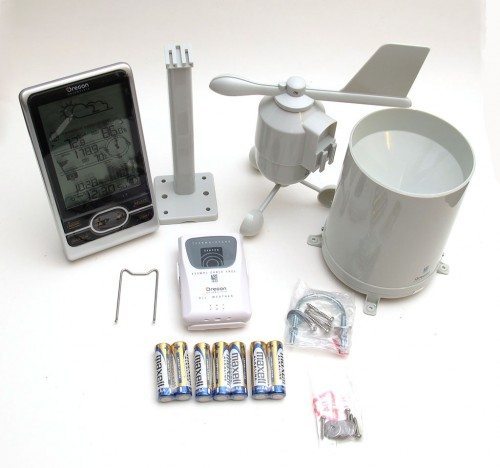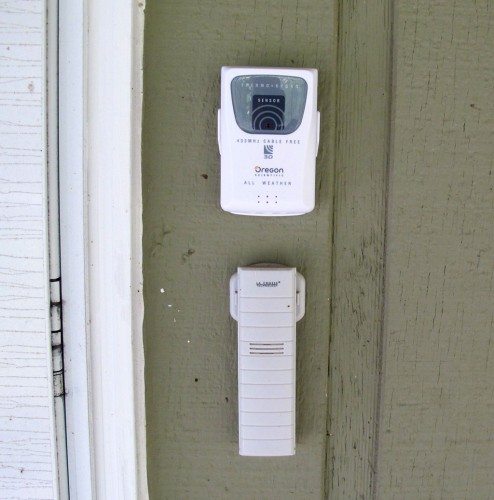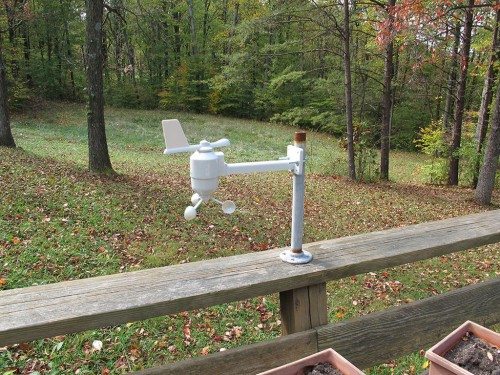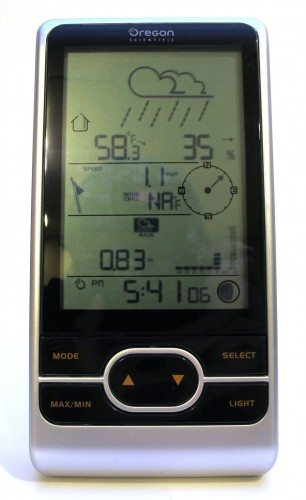Do you check the local weather on your smartphone or computer before you leave for the day? Or maybe you turn on the TV to watch a meteorologist’s broadcast. Have you ever wondered why weather people called meteorologist’s? They don’t study meteors… 🙂 Anyway, most of us like to know what it’s like outside so that we can dress appropriately for the day, or just crawl back under the covers when it’s dumping rain. The WMR86 Backyard Pro Wireless Weather Station from Oregon Scientific gives you all the weather info you need including temperature, wind speed and rain fall. Let’s take a look.
Note: Click the images in this review to see a larger view.
Package Contents
Base Station
Wind Sensor with mounting hardware
Temperature & Humidity sensor with mounting hardware
Rain Gauge with mounting hardware
Instructions
Batteries
This kit comes with everything you need (except for a screw driver) to setup on the inside and outside of your house.
The temperature & humidity sensor (top sensor in the image above) is powered by 2 AAA batteries and is easily attached to the outside of your house using the included plastic snap in holder and screws. There’s a small LED status indicator on the outside and a Celsius / Fahrenheit temperature switch in the battery compartment.
The wind sensor is powered by 2 AA batteries and comes with a plastic bracket and mounting hardware that will allow you to screw it into a flat surface or attach it to a post like I’ve done.
There are two parts of the wind sensor that move. On the top is a flag shaped arm that swivels to capture the wind direction. Note that after I took the picture above, I noticed that I had the sensor pointing the wrong direction. The instructions say to make sure that it’s pointed North and I had it pointed South…
The part on the bottom with the three cups rotates to record wind speed, so it’s important to locate the wind sensor in a relatively open area away from trees and other obstructions.
The other outdoor sensor is the rain gauge, which is powered by 2 AA batteries. The instructions advise you to mount it in the open 3 feet or so from the ground. I ended up mounting it on a bench on our back patio that we never sit on.
Inside the gauge is a little cup that collects rain water and automatically dumps it out when it gets full. In my infinite brilliance, I didn’t realize that the cup was taped to keep it from flopping around in shipment. I kept wondering why the gauge wasn’t working and finally took it apart to discover the tape. Moral of the story… even when you think you’re too smart to read directions, do it anyway 😉
After all of the outside sensors are installed, you’re ready to start viewing their data on the base station.
The base station has a large LCD display (2.75 x 4 in) that includes a backlight button that lights the display for 5 seconds when pressed. The display is separated into 4 sections. The top section has a large graphic that represents the current weather status. As you can see, when I took the image above, it was a rainy day. Below the weather graphic is the current temperature and the humidity level. The arrow buttons cycle through channels 1-3 if you have additional temperature sensors. It will also allow you to see the indoor temperature and humidity level. Small arrows on the display next to the readings tell you if the temp/humidity levels are going up, down or remaining the same. In the image above, you can see that the outdoor temp is going down, but the humidity level is steady.
Below the temperature section of the display is the wind sensor area where the current wind direction, speed and wind chill info are shown. Pressing the Min/Max button on the base will also toggle between the last minimum reading and maximum reading, with time stamp.
Below the wind sensor section is the rain gauge section that displays the last 24 hours of rain fall data, barometric pressure readings and the last 10 hours of UV index info. Pressing the mode button cycles through these 3 screens in that section of the LCD display. I find this section the hardest to read because the graphs use a very small font to label each axis.
The bottom section of the LCD is reserved for the clock / calendar and moon phase display. The time and date are automatically via radio reception to an atomic clock which automatically adjusts for time zone and daylight savings. You can cycle through 3 ways to view the time/date. Next to the time is a graphical representation of the current moon phase.
I don’t have any complaints about this setup other than the rain gauge graphs area bit hard to read on the mono LCD because they are so small. I’d love a full color LCD, but then the batteries would need constant changing. Speaking of batteries, there is an indicator in each sensor section of the LCD when one of the outdoor sensor batteries is low. That’s a nice touch.
The Oregon Scientific WMR86 Backyard Pro Wireless Weather Station is easy to setup and easy to use. I like the large display that provides all the weather info that you need at a glance. I also appreciate the fact that all the components are powered by regular alkaline batteries that are readily available. Nothing irks me more than gadgets that use expensive and / or not so easy to find odd batteries. Now that Winter is almost here, I’m sure I’ll be consulting this device before I leave for work each morning so I’ll know if I’ll need gloves and a scarf.
Wireless Charger iPhone Charging Station - 3-in-1 Magnetic MagSafe Charger Multiple Devices for Apple, 15W Fast Charging Foldable Travel Charging Pad for iPhone 17/16/15/14/13/12, AirPods, Apple Watch
48% OffWireless Charger iPhone Charging Station: 3 in 1 Charger Stand Multiple Devices for Apple - iPhone 17 16e 16 15 14 Pro Max 13 12 11 - Watch 10 9 8 7 6 5 4 3 2 SE and Ultra Series - Airpods 4 3 Pro
38% OffProduct Information
| Price: | $149.99 |
| Manufacturer: | Oregon Scientific |
| Pros: |
|
| Cons: |
|








Gadgeteer Comment Policy - Please read before commenting
I’ve been looking for one of these! Thanks for the review!
Pretty kitty! And I LOVE the area around your house! Autumn looks so gorgeous!
@Andy Thanks! Max probably would not like to be called “pretty” since he’s a boy 😉
All kitties are pretty! (and I’m not a cat person)
Nice review.
How (and where) does it measure the pressure ?
@io I don’t know “how” it measures, but I believe the sensor is in the rain gauge.
Hi
Is there a way to get the data from this wheter station to the PC.??
Tore,
Looks like you can’t. However, the bigger model has PC connection.
Kenny
I haven’t tried but I think you could get data from the wireless sensors with device like this http://www.uk-automation.co.uk/products/RFXCOM-RFXtrx433.html
My old one sent out readings 300 yards. How far does the Oregon Scientific WMR86A Pro Wireless Weather Station send out readings, it don’t say in the user guide?
Thanks
I got one of these for Christmas and cannot get the wind sensor to sync with the base station. I followed directions to check before setting up outside and nothing shows on the base station screen. Temperature and rain gauge work. Any ideas?
@Tom did you check the obvious: fresh batteries, battery orientation? If that doesn’t help I think you’ll need to contact Oregon Sci…
Same here! I bought one for my husbans Birthday, he is trying it out now, but the wind sensor doesn´t work…what to do? Did you get any help,Tom?
Hi everyone
I have the oregon pro wmr86n and cant get a wind chill reading Anyone else having the same problem?
Yes, switched batteries, reset both base station and wind sensor, etc. Nothing worked.
Help! Can someone help me troubleshoot a Pro Weather Station-WMR86A.
After several years of satisfactory use, the wind sensor suddenly quit sending. So I took everything apart, including the rain gage, changed batteries. The wind sensor still will not work. Don’t know if the rain gage works now because we have not had any rain for several months. I made sure all the batteries are right, after checking their voltages (all good).
I may need a new WGR800 wind sensor. Have not been able to get the web site to work for me.
HI Dave
Can you tell me how long the rain gauge holds a history for? As far as I can tell it only goes up to 24h? So you can’t compare rainfall over a longer period?
Thanks